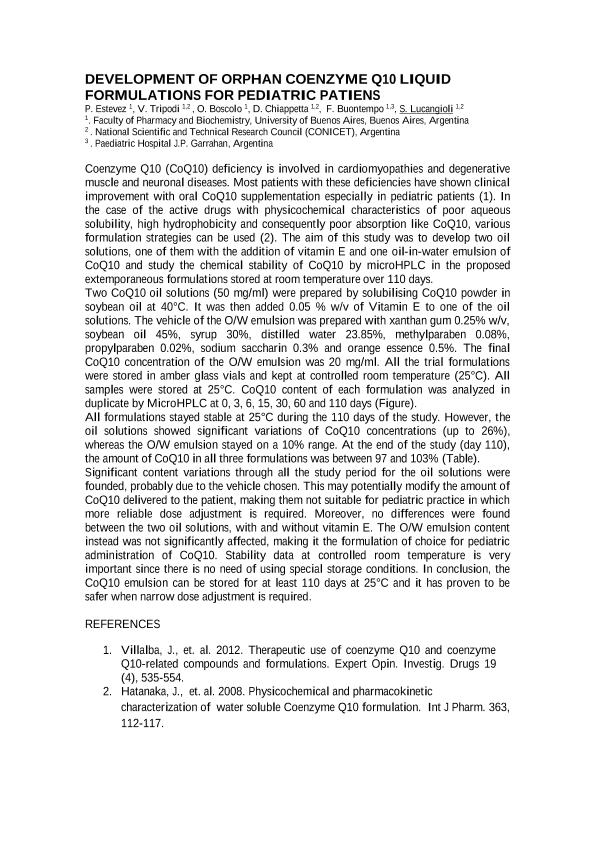Artículo
Development of orphan coenzyme q10 liquid formulations for pediatric patiens
Estevez, Pablo Nicolas; Tripodi, Valeria Paula ; Boscolo, O.; Chiappetta, Diego Andrés
; Boscolo, O.; Chiappetta, Diego Andrés ; Buontempo, Fabian; Lucangioli, Silvia Edith
; Buontempo, Fabian; Lucangioli, Silvia Edith
 ; Boscolo, O.; Chiappetta, Diego Andrés
; Boscolo, O.; Chiappetta, Diego Andrés ; Buontempo, Fabian; Lucangioli, Silvia Edith
; Buontempo, Fabian; Lucangioli, Silvia Edith
Fecha de publicación:
08/2013
Editorial:
Elsevier Science
Revista:
European Journal Of Pharmaceutical Sciences
ISSN:
0928-0987
Idioma:
Inglés
Tipo de recurso:
Artículo publicado
Clasificación temática:
Resumen
Coenzyme Q10 (CoQ10) deficiency is involved in cardiomyopathies and degenerative muscle and neuronal diseases. Most patients with these deficiencies have shown clinical improvement with oral CoQ10 supplementation especially in pediatric patients (1). In the case of the active drugs with physicochemical characteristics of poor aqueous solubility, high hydrophobicity and consequently poor absorption like CoQ10, various formulation strategies can be used (2). The aim of this study was to develop two oil solutions, one of them with the addition of vitamin E and one oil-in-water emulsion of CoQ10 and study the chemical stability of CoQ10 by microHPLC in the proposed extemporaneous formulations stored at room temperature over 110 days.
Two CoQ10 oil solutions (50 mg/ml) were prepared by solubilising CoQ10 powder in soybean oil at 40°C. It was then added 0.05 % w/v of Vitamin E to one of the oil solutions. The vehicle of the O/W emulsion was prepared with xanthan gum 0.25% w/v, soybean oil 45%, syrup 30%, distilled water 23.85%, methylparaben 0.08%, propylparaben 0.02%, sodium saccharin 0.3% and orange essence 0.5%. The final CoQ10 concentration of the O/W emulsion was 20 mg/ml. All the trial formulations were stored in amber glass vials and kept at controlled room temperature (25°C). All samples were stored at 25°C. CoQ10 content of each formulation was analyzed in duplicate by MicroHPLC at 0, 3, 6, 15, 30, 60 and 110 days (Figure).
All formulations stayed stable at 25°C during the 110 days of the study. However, the oil solutions showed significant variations of CoQ10 concentrations (up to 26%), whereas the O/W emulsion stayed on a 10% range. At the end of the study (day 110), the amount of CoQ10 in all three formulations was between 97 and 103% (Table).
Significant content variations through all the study period for the oil solutions were founded, probably due to the vehicle chosen. This may potentially modify the amount of CoQ10 delivered to the patient, making them not suitable for pediatric practice in which more reliable dose adjustment is required. Moreover, no differences were found between the two oil solutions, with and without vitamin E. The O/W emulsion content instead was not significantly affected, making it the formulation of choice for pediatric administration of CoQ10. Stability data at controlled room temperature is very important since there is no need of using special storage conditions. In conclusion, the CoQ10 emulsion can be stored for at least 110 days at 25°C and it has proven to be safer when narrow dose adjustment is required.
Palabras clave:
Coenzyme Q10
,
Orphan Formulation
,
Pediatrics
Archivos asociados
Licencia
Identificadores
Colecciones
Articulos(OCA HOUSSAY)
Articulos de OFICINA DE COORDINACION ADMINISTRATIVA HOUSSAY
Articulos de OFICINA DE COORDINACION ADMINISTRATIVA HOUSSAY
Citación
Estevez, Pablo Nicolas; Tripodi, Valeria Paula; Boscolo, O.; Chiappetta, Diego Andrés; Buontempo, Fabian; et al.; Development of orphan coenzyme q10 liquid formulations for pediatric patiens; Elsevier Science; European Journal Of Pharmaceutical Sciences; 8-2013; 69-70
Compartir



